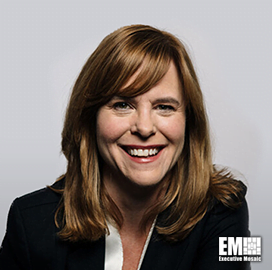
Leigh Palmer
SVP, Defense
GDIT
Member Profile: Leigh Palmer, SVP of Defense for GDIT
Leigh Palmer, senior vice president for the defense division of General Dynamics Information Technology, recently spoke with the Potomac Officers Club for an exclusive Executive Spotlight interview detailing her career in the federal sector, the insights she gleaned from the COVID-19 pandemic and how diverse perspectives can strengthen company culture. Palmer also comments on her adaptability-focused approach to leadership, building an empathetic workplace and delivering cutting-edge capabilities to GDIT’s government customers.
What can you tell us about your background and how you’ve been able to adapt to the ever-changing challenges of the federal landscape over the course of your career?
“Throughout my more than 25-year career in this industry, I’ve always valued my professional network across the defense community. I have worked for defense contractors such as Northrop Grumman, BAE Systems, CSRA, and now General Dynamics Information Technology (GDIT) since 2018. I am a Virginia Tech graduate and hold a master’s degree from the University of Pennsylvania. I am also proud to serve on the board of the nonprofit Intelligence and National Security Alliance as well as AFCEA International’s executive committee.
In my current role as a senior vice president of the defense division at GDIT, I oversee a $3B+ business portfolio comprised of 10,000 employees working at 88 locations across the world. Our technology experts support some of the most complex defense and intelligence projects around the globe.
GDIT is a leader in next-generation networking, cloud, cyber, mobility and artificial intelligence/machine learning, and we are very proud to deliver state-of-the-art solutions that advance critical missions. We succeed by understanding our military customers and delivering what they need, when they need it. I rely on resourceful, high-performing expert teams with essential skills and a determination for solving big problems. In forming our teams, we make it a priority to include veterans, who bring deep knowledge of the service. Ultimately, we are well positioned to consistently deliver innovative technology, positive impact and value for our customer.
As a general approach, I try to remain flexible and open to possibilities and inspire others to do the same. While change is indeed challenging, I’ve always viewed challenges as opportunities, and opportunities are where true leaders excel. For example, we continue to secure and deliver next-generation capabilities. Anticipating the importance of the DoD’s pivot to an all-domain strategy in the Joint All-Domain Command and Control (JADC2) environment, we have been intentional in our efforts to enhance our offerings in cloud, and identity credentialing and zero trust architectures. Our teams are always pushing to be at the forefront of delivering solutions, and we will continue to innovate and pivot at increased speed as world events require.”
What do you believe are your core strengths as a leader and what lessons taught you the most about driving success?
“Throughout my career I’ve always centered my strategy around my team. Developing exceptional leadership teams and ensuring we remain hyper-focused on our people and culture is fundamental. I am fortunate to work with some of the best talent in the industry! As a government contractor, we have an obligation to attract, retain and develop leading technical talent, and I’m very proud of how we actively promote and support professional development, including technical certifications, to make our employees more valuable to our customers and more mobile within GDIT. We really want GDIT to be a place where our employees feel they can grow and build rewarding careers. This year we are on track to increase our technical learning hours and certifications by 10% and internal mobility by 45% over 2020.
If we have learned anything from the global pandemic, it’s the importance of agility and resilience. We have developed a strategy for the organization predicated on agile operations, and we’ve challenged our employees to thrive in a culture of innovation. Our results are impressive: we’ve accelerated enhanced offerings in cloud, mobility, and artificial intelligence to DoD.
Our team has also worked side-by-side with government users to roll out Microsoft Office 365 for secure collaboration across the Department of Defense through the DEOS program – an especially important requirement given the need for many people to work from remote locations during COVID. While this collaborative technology isn’t new, the scale and reliability of location-flexible work tools has surpassed anything previously operationalized. Our ability to quickly respond to rapidly changing customer mission needs is a testament to our teams’ resilience, and another example of GDIT’s agility as an organization.
Over the last couple of years, we’ve learned a lot about the importance of encouraging our employees to bring their whole selves to work. We’ve had to navigate ever-changing COVID restrictions, and just prior to the pandemic we completed a major organizational integration. Through these experiences, we’ve transformed ourselves as leaders and realized how important it is to be empathetic and open to different perspectives. We need to recognize that we are all human, and we are all juggling different needs and responsibilities in our personal lives. We want to be a workplace that embraces this reality, and we want to provide an environment where our teams can remain engaged and productive in flexible ways. This focus on empathy is what makes our leadership team unique, and as leaders we have to model what we say we value. If I bring my whole self to work, it lets others know that it’s okay to be open, which leads to richer, more meaningful conversations and interactions that benefit us all.”
How would you describe your management style and core values toward building a winning culture?
“I’ve been laser focused on developing talent and taking care of our people. I believe in leading with empathy and compassion, and also ensuring those on my team are accessible and prioritizing flexibility during this very difficult period. It’s been a unifying time, fueled by dedication to our customers’ missions, and while it has been incredibly tough, we have emerged as a stronger, more engaged team and company.
This year has also crystallized the importance of encouraging leadership at all levels. One of my primary motivations is the opportunity to develop tomorrow’s leaders in the defense community. I’ve had wide-ranging conversations across our division and focused on mentoring and building roadmaps for our people, all in an effort to help them thrive.
Ultimately, our success is not about me. It is about bringing people together to develop innovative solutions for complex problems. This requires a strong work ethic, a commitment to transparency, and a readiness to listen. We have to work hard, be accountable, and sometimes have tough conversations – both good and bad. We have challenging jobs, we expect a lot from our leaders, and we will continue to ask more of them every day. To get the most from our teams, we must empower them, coach them and recognize that there will be bumps along the way. At the end of the day, we can only succeed with great people.
I also have a deep sense of personal responsibility to bring a diversity of perspectives to the table. I think of diversity in its broadest sense – DoD experts, people who bring commercial best practices, people of all ages, etc. I truly believe the way to go after a problem is to deploy many great minds to develop the solution, which means building a diverse team. The winning team culture is one that is inclusive and values all perspectives.”
If you were given free reign to enact changes in the federal landscape, what are the first three changes you would implement and why?
“First, we need to bring in multiple perspectives. Whether we’re talking about commercial technical experts, system integrators or government users, they each have an important role to play. We need to listen to – and learn from – each other in order to come up with the best solutions for the warfighter. We also need to continue to create greater connections within this ecosystem to drive collaboration and rapid innovation for our customers.
We must do a better job of leveraging existing capabilities. We have access to so much technology in the federal landscape, but we are not making optimal use of all that is available to us. We have to start with the mindset that warfighter needs come first, and work from there to identify and bring proven solutions to the mission.
Above all, we can’t fight our wars without a strong IT foundation. Technology is fundamental to the warfighter, and the speed of information exchange, secure collaboration, and getting intelligence to the edge are strategic differentiators on the battlefield. We’ve seen the significance of IT during COVID, and we can’t lose sight of its importance.

Category: Executive Profiles




